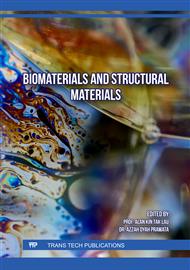[1]
L. Fan, S.H. Hu, Y.G. Wu, H.R. Yao, B. Zhou, X. Xin. Research Progress on chemical identification of aging of butyl hydroxyl propellant[J]. Journal of Explosives, 2017, 40(04): 8-14.
Google Scholar
[2]
X.G. Zhang. Study on storage aging characteristics and life estimation of HTPB propellant[D]. National University of Defense Technology, 2009.
Google Scholar
[3]
Z.H. Guo. Study on aging properties of HTPB solid propellant[D]. Harbin Institute of Technology, 2021.
Google Scholar
[4]
J.M. Liu, J.S. Xu, X. Chen, H. Li, X.G. Fan. Main curve of tensile mechanical properties and strength of heat-aging modified bibase propellant[J]. Energetic Materials, 2021, 29(09): 819-826.
Google Scholar
[5]
G. Yan, S.L. Yu, Q. Wang, J.J. Du, F.F. Wang. Research on aging behavior and safe storage life prediction of modified double base propellant[J]. High Temperature Materials and Processes, 2022, 41(1).
DOI: 10.1515/htmp-2022-0234
Google Scholar
[6]
J. Rocco, J. Lima, A.G. Frutuoso, et al. TG studies of a composite solid rocket propellant based on HTPB-binder[J]. Journal of Thermal Analysis & Calorimetry, 2004, 77(3): 803-813.
DOI: 10.1023/b:jtan.0000041659.97749.fe
Google Scholar
[7]
Y.H. Tang, K.H. Dong, C.L. Zhang, C. Yu. Research on health status monitoring of composite solid propellant based on electrochemical sensor[J]. Ship Electronic Engineering, 2018, 38(01): 112-114+124.
Google Scholar
[8]
L.G. Duan, G. Wang, H.F. Qiang, X.R. Wang, S.C. Zhang, L. Xiao. Research on monitoring of solid propellant aging by piezoelectrical impedance technology[J]. Propulsion Technology, 2019, 40(08):1912-1920.
Google Scholar
[9]
K. Luo, X. Chen, H. Zheng, et al. A review of deep learning approach to predicting the state of health and state of charge of lithium-ion batteries[J]. Journal of Energy Chemistry, 2022, 74(11): 159-173.
DOI: 10.1016/j.jechem.2022.06.049
Google Scholar
[10]
J. Ryan. Deep learning object detection in materials science: Current state and future directions[J]. Computational Materials Science, 2022, 211.
DOI: 10.1016/j.commatsci.2022.111527
Google Scholar
[11]
P.G. Peng, P.L. Liu, R. Zhang, et al. Properties and principles of solid propellant[M]. Changsha: National University of Defense Technology Press, 1987.
Google Scholar
[12]
Ministry of Aerospace Industry. High temperature accelerated aging test method of composite solid propellant: QJ 2328A-2005[S]. Beijing: Industry Standard-Aerospace, 2005-01-01.
Google Scholar
[13]
S. Wasterlain, D. Candusso, F. Harel, X. François and D. Hissel, "Diagnosis of a fuel cell stack using electrochemical impedance spectroscopy and Bayesian Networks," 2010 IEEE Vehicle Power and Propulsion Conference, 2010, pp.1-6.
DOI: 10.1109/vppc.2010.5729184
Google Scholar
[14]
Y.K. Shi. Research on the application and system realization of piezoelectrical impedance method in structural health monitoring[D]. Yangtze University, 2019.
Google Scholar
[15]
B. Prabakaran, K. Vikram, A.S. Y, A. Marco, A. Mohamed. Comparison of neural networks based on accuracy and robustness in identifying impact location for structural health monitoring applications[J]. Structural Health Monitoring, 2023, 22(1).
DOI: 10.1177/14759217221098569
Google Scholar
[16]
W.X. Xu, P. Song, J.W. Tan. Research on rolling bearing fault diagnosis method based on KPCA-BP network model[J]. Coal Mining Machinery, 2014, 35(08): 265-267.
Google Scholar
[17]
T.X. Xu, H.J. Chen, K.N. Teng, J.Y. Gu. Combined model of missile storage life estimation[J]. Fire Power and Command Control, 2011, 36(10): 124-126+130.
Google Scholar
[18]
X.J. Zhang, P.T. Xing, H.M. Shu, J.J. Zhu, X.L. Chang. Experimental study on accelerated aging of HTPB propellant with humid heat[J]. Aging and Application of Synthetic Materials, 2022, 51(05): 1-4+134.
Google Scholar


